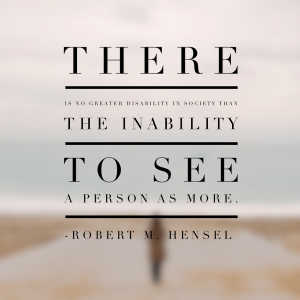 A while back I wrote about the experience of silently struggling with invisible disabilities.
A while back I wrote about the experience of silently struggling with invisible disabilities.
Sometimes, a person does not label themselves as living with a physical, psychological, or neurological challenge because they have been dealing with the issue or problem for most of their lives. In that previous blog, I tackled the difficulties of coping with chronic pain, illness, or learning disabilities in the workplace.
Then there’s how coworkers, management, and business owners can help make the silent suffering finally heard, and once more, address the problem productively.
One aspect I haven’t addressed yet is employees or job candidates who have disabilities that are more visible. What are their daily challenges, and how often is ableism (a bias in favour of able-bodied people) in the workforce affecting them professionally?
 Since I deal on a regular basis with HR concerns and clients who are seeking career guidance, I see the consequences of discrimination that a person with visible disabilities encounters. This is especially true for someone attempting to find employment.
Since I deal on a regular basis with HR concerns and clients who are seeking career guidance, I see the consequences of discrimination that a person with visible disabilities encounters. This is especially true for someone attempting to find employment.
One client expressed her frustration stating,
“As soon as I get through the intense online screening, I know my biggest challenge will be the face-to-face interview. Once the interviewer sees my physical disability they usually begin to underestimate my intelligence … even though I have a stellar education and resume to back me up. Then, if I actually do get the job I still have to work in an environment that lacks the accommodations that are literally around every corner…”
If you’d like to know more about ableism and discrimination based on disability, please visit the Ontario Human Rights Commission website.
I’ve heard from people who have faced ableism in the workplace say that it’s about the actual workspace itself. For example, discomfort in their work environment because there isn’t enough physical space for them to do their job effectively. There might be no chair to sit on, instead of standing for long hours. There might not be adequate room for a wheelchair to pass through. When those physical limitations are paired with insensitive or disrespectful attitudes from co-workers and employers, the job can be much more difficult to navigate.
Those challenges are not the fault of the person with the disabilities. The responsibility rests entirely on management and owners to make a reasonable effort to address their employees’ needs and not marginalize or penalize them for having different requirements to get the job done. In Ontario, this is the law – click here to learn more about it.
 Problematic scenarios that clients have described how often an office, a retail establishment, a classroom, or other setting excludes certain people – even though the exclusion may not be intentional.
Problematic scenarios that clients have described how often an office, a retail establishment, a classroom, or other setting excludes certain people – even though the exclusion may not be intentional.
We are familiar with the ways that people with physical disabilities are acknowledged in public spaces. For example, parking lots with wider spaces near entrances, specialized crosswalks for people with impaired vision, ramps or elevators in or outside of buildings, buses with lifts, lower curbs on sidewalks, etc. Obviously, these are excellent developments but certain actual office/workspaces are not as suitable for everyone. As one source said,
“It doesn’t always start with the stairs … sometimes the struggle is the simple task of dealing with the width of a door. Able-bodied people will complain it’s hard to get a foot in the door when it comes to job hunting…I say try it with a wheelchair!”
This got me thinking about how companies, both big and small, can make their spaces, more inclusive for workers and potential clients/customers with disabilities. This also includes how organizations can conduct their hiring practices so that they only assess the skills and abilities that are needed for the role, and avoid ableist language and its consequences.
Three ways your workplace can start to work for everyone:
1. Widen Your Search
In my opinion, we’re at a point at which diversity deserves to be the concept of the year. This is most true in the workplace. The hidden potential of people who have been marginalized and overlooked because of their gender, physical ability, race, or ethnicity is finally being sought. We’re finally at a point where companies are adapting their hiring practices so that they can intentionally include people who have neurological differences (e.g., attention deficit disorder (ADD), attention deficit disorder with hyperactivity (ADHD), being on the autism spectrum and dyslexia). These companies are benefiting from neurodiversity.
People with disabilities who have the appropriate experience and training/education are just as qualified to work, and yet all too frequently they are denied meaningful employment. My advice is for organizations to focus on evaluating the relevant work-related behaviours in a non-biased manner when looking for new employees.
2. Language is Powerful
Intuitively, we all know that when speaking with or about someone respectful language is vital. This is especially true in the places where we work. What if words you thought were harmless or benign were actually offensive and hurtful? I’m still learning that this often happens to people with disabilities who hear demeaning language directed towards them. Here is a short and helpful guide to making your language more respectful.
3. Space is Support
Making an inclusive space within your work environment goes a long way to building an organization that benefits from all the advantages of diversity. An accessible workstation, and/or the ability to work from home, is just one way a company can start to be better equipped for all types of employees. Another way is to consider making some adaptive technological changes, alternate formats or audio devices, as well as flexible hours that still enable productivity.
For additional information and resources about how to seize the opportunity to advance your business by including people with disabilities visit Discover Ability Network.
Have you ever wished you could get inside the head of a hiring manager? You can. Dr. Helen Ofosu is a Career Coach/Counsellor with a difference. She has worked for organizations to create hiring and screening tools. She’s created countless pre-screening tests, interviews, simulations, and role plays for organizations of all kinds.
Dr. Helen’s training in Industrial and Organizational (I/O) Psychology means she is a genuine expert in evaluating work-related behaviours. She uses those skills to help hiring managers tell the difference between people who say the right things during interviews and people who actually deliver on the job. In other words, Dr. Helen understands first-hand how job candidates are assessed.
Do you need help navigating the world of work? Contact Dr. Helen today for a free and confidential initial consultation by phone, email, or via direct message on Twitter, Facebook, or LinkedIn.
More than career coaching, it’s career psychology®.
I/O Advisory Services – Building Resilient Careers and Organizations.
Please share this article using any of the social media icons below.



